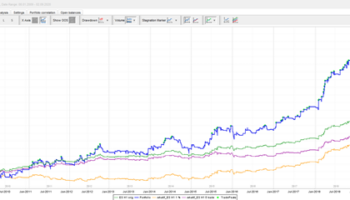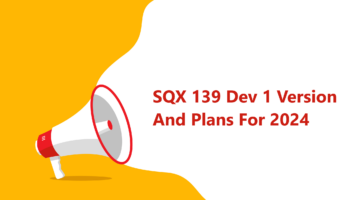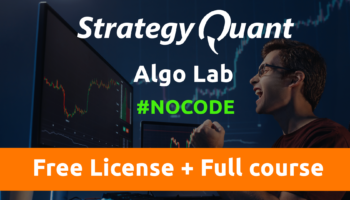Futures contracts have been around for over 300 years. It provides opportunities not only to hedge against future price fluctuations in various commodities and financials and also to speculate and trade more actively both manually and algorithmically. StrategyQuantX offers a very efficient to do so. Let make this a short introduction into futures trading. In the next article we will then focus on more technical side of the thing and start creating our first futures trading strategies.
Before we move to specific markets and contracts to trade we first need to get familiar with important aspects of futures trading.
Futures trading is NOT a zero sum game
At any time in futures markets number of market participants being ‘short’ is always equal to those being ‘long’. Hence the term ‘zero sum game’. Actually it is not completely true since each party (buyer and seller) has to pay transaction fees called round-turn commissions.
At any moment anybody can come into the futures market and buy or sell futures contracts if there is enough liquidity. The only requirement is to deposit a small fraction of contract value as margin at your futures broker. Since most brokers require margin that represents only a small fraction of contract value, you are usually able to control assets of significantly high value with tiny amount of money. This is called a leverage.
Futures leverage can work for you
Most of the people think that the leverage is a bad and dangerous thing. I personally don’t think so. I can’t see the difference between risking 500 USD trading Apple stocks and risking 500 USD trading crude oil futures or e-mini futures markets for example. It all depends on your trading system, personality, risk tolerance etc. Thanks to margin trading, with smaller accounts you can more effectively use your capital and build a portfolio of several products for diversification purposes.
Maintenance margin & day trading margin
There is a big advantage for day traders which is a discounted intraday margin required to hold futures positions during regular trading hours (trading hours are usually split to pre-market and regular session). Most brokers usually require only a fraction of maintenance margins required to hold position overnight. It’s simply because it is expected traders have much more control over what happens during the day within normal trading hours.
Imagine you have a 2,000 USD account with a futures broker. For trading crude oil futures your broker usually requires about 1,000 USD intraday margin and 3,000 USD maintenance margin. You won’t be able to hold open position overnight but you can buy or sell at least one crude oil futures contract withing intraday trading hours which gives you the opportunity to hold the contract of 1,000 barrels which means for each 1 USD price change in crude oil market contract you will make or lose 1,000 USD.
First notice day, last trading day
Since most of traders are registered as ‘speculators’, you will never have to face up a situation of delivering an underlying product (like 127 tuns of corn or 1,000 barrels of oil). Your futures broker will most likely close your position around the First Notice Day (FND) which is usually the day after which you may be required to take physical delivery (as a commercial participant) of the contract’s underlying commodity. FND varies by contract and also depends on exchange rules. Some futures contracts doesn’t even have FND listed. If the first business day of the delivery month was Monday, Sep. 1, first notice day would typically fall one to three business days prior, so it could be Wednesday, Jul. 26 or Thursday, Jul.27 etc. Most traders close out their positions before FND. Last Trading Day is a day at market actually stops trading. No more transactions are done after that date at exchanges and all positions are settled.
Futures rollover dates
This is an important part for position and swing futures traders who usually want to hold their positions for several days or weeks. Common practice here is to close current position right before FND and open a new position in following contract months (usually next nearest). Let’s say you bought one e-mini Dow futures contract (YM) on 1st March 2021. The front contract month here with the highest liquidity is the March contract – YMH21 (March is marked with letter ‘H’). For some reason you decide you are going to keep it as long as possible. The best practice here is to rollover about 7 days before 3rd Friday of the contract month which in this case is the Friday 12th March 2021. So you sell YMH21 to close position and open a new long position using the YMM21 futures contract.
Delivery months
Each futures contract has its delivery month specified. For stock index futures these are March, June, September and December. For crude oil futures it’s all twelve months from January to December while exchange always lists contracts for several years forward. Crude oil futures are listed nine years forward using the following listing schedule: consecutive months are listed for the current year and the next five years; in addition, the June and December contract months are listed beyond the sixth year. Additional months will be added on an annual basis after the December contract expires, so that an additional June and December contract would be added nine years forward, and the consecutive months in the sixth calendar year will be filled in. Bit complicated it seems but most of traders out there usually use the front and the most liquid month. Here are futures contract months codes:
| January |
F |
| February |
G |
| March |
H |
| April |
J |
| May |
K |
| June |
M |
| July |
N |
| August |
Q |
| September |
U |
| October |
V |
| November |
X |
| December |
Z |
So to refer to the actual price for the December 2021 crude oil contract you will check the CL Z 21 symbol.
As for using algo-trading strategies you need to be aware of contract expiration and rollover. It is not an issue really if you do not intend to hold your open positions for months.
Cost of trading futures
Fee structure used for futures trading is quite straightforward. Most broker will charge you just one time fee so-called ’round-turn commission’ which is anywhere between 3 to 6 USD per single futures contract (roundturn means trade entry and trade exit) with most retail brokers. And that’s basically all about it.
Platforms to trade futures strategies built in StrategyQuantX
Nowadays you have more options. StrategyQuantX supports EasyLanguage and MQL5 so you can operate your futures strategies in both MetaTrader5 and TradeStation trading platform. Another high quality platform is MultiCharts (EL version) that allows you to execute many strategies while being connected to multiple broker at once and build highly efficient portfolios.
Best futures contracts for algo trading strategies
The best markets are those where there is an opportunity for profits and enough liquidity to execute your trades without significant additional costs. Also significant trends (even long-term) are very common across commodities. To make sure the contract is actively traded you need to check the volume information. In most cases we’ll want to trade the front month contract that is the one with closest to the expiration. This contract in most cases has the largest daily volume. It is OK to trade the September Corn contract in May but it you need to check volume there vs in the July contract. Commonly the daily volume for the front month Corn futures reaches easily 100,000 contracts which can be well considered enough.
If you check CME Group website for listed futures contracts there are few main categories
such as Agriculture, Energy, Equity Index, Metals, FX and others. Many we will check in the next article especially how to setup the build process and find first successful strategies.
Let’s summarize
This topic can be very complex of course but you don’t have to know everything to be a consistently profitable trader. Most of stuff you will learn as you progress on your path to profitability and successful trading. I also recommend you to check CME Group website for listed futures contracts and look at them little bit deeper. I believe that futures is definitely a worth product every trader or investor should consider adding to his/her portfolio. The main advantages are following:
- you can start trading with relatively small account using retail futures brokerage services
- since there are usually low margin requirements for the most futures contracts, you can effectively build a portfolio
- you can control large value so the leverage can work for you as well as against you
- there are hundreds if not thousands of futures contracts listed at futures exchanges around the world
- you can use futures for hedging other products in your portfolio
- you can participate on seasonal price fluctuations using outright futures or more complex futures strategies (calendar spreads, butterflies, etc)



